Many birds’ migratory divide splits Missouri in half, and produces a great variety of species during this time. The Great Plains of Missouri offer incredible birdwatching all year, especially for woodpeckers.
Woodpeckers typically do not migrate aside from a couple species, giving Missouri birdwatchers all year to complete this list.
Our guide below will describe all the woodpeckers you’re likely to encounter and help you identify them next time you’re outdoors.

You May Also Like: Check Out These 12 Incredible Woodpeckers in Arizona complete with Photos, Facts, Guide, and more!
1. Northern Flicker
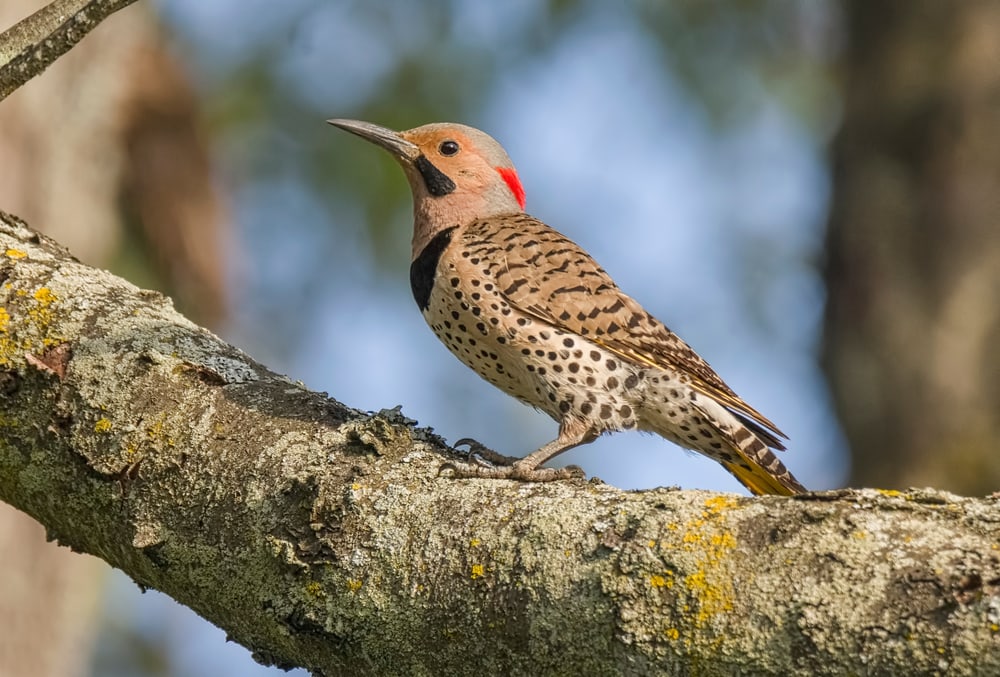
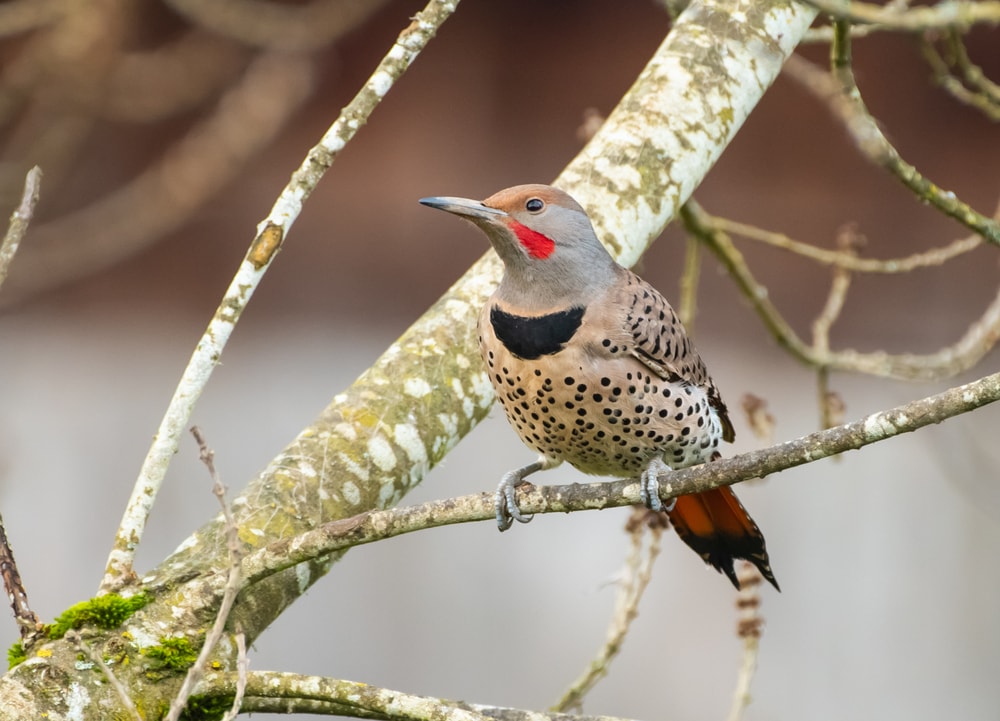
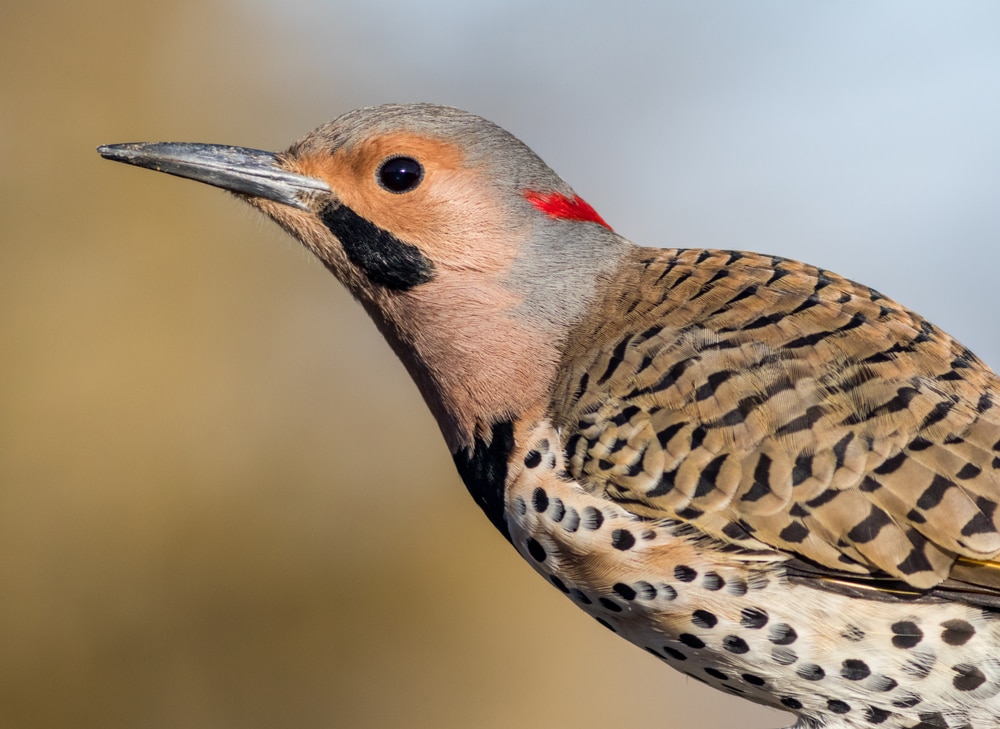
Size
The Northern Flicker is 11 to 12 inches (29.4 cm to 30.5 cm) tall, with a 16 to 20 inch (40.6 cm to 50.8 cm) long wingspan. This Flicker will weigh between 4.5 and 5.5 ounces (113.4 g and 155.9 g).
Identification
You’re likely only to see the yellow-shafted species in Missouri, defined by the black whisker off of their beak or bright yellow color underneath their wings. A Flicker’s light brown coloring and black-spotted chest give it an appearance unique from all other woodpeckers of Missouri.
Infrequently, the red-shafted species will stray into western Missouri. Their red whisker is the most noticeable difference. In-flight, the deep red color underneath the wings differentiates them from their yellow-shafted relatives.
The two species are known to hybridize, which can make identification difficult. This is where knowing the subtle markings of each species becomes important. Hybrids often have a red and black mixed whisker or a peach color to their face.
Description
One of few woodpeckers found in North America that is migratory. The Northern Flicker is found year-round in Missouri, making their homes at the edge of forests.
These birds are often seen in your backyard combing the forest floor and trees for insects. Natural bullies, their size, and volume make it easy to scare off smaller visitors. If a group moves in, expect to be refilling your feeder sometime soon.
If you are ever wondering what is drumming on the side of your house, it’s likely the Northern Flicker looking for love. Opting for volume over display, the Northern Flicker is one of two birds on the list that seeks out metal to ensure he is the loudest.
2. Hairy Woodpecker
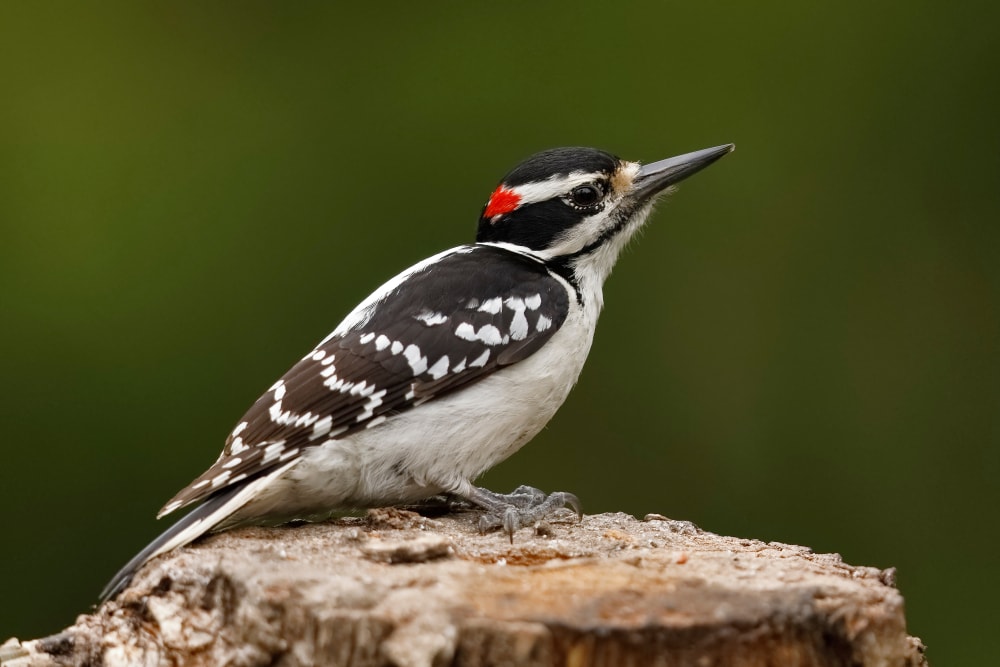
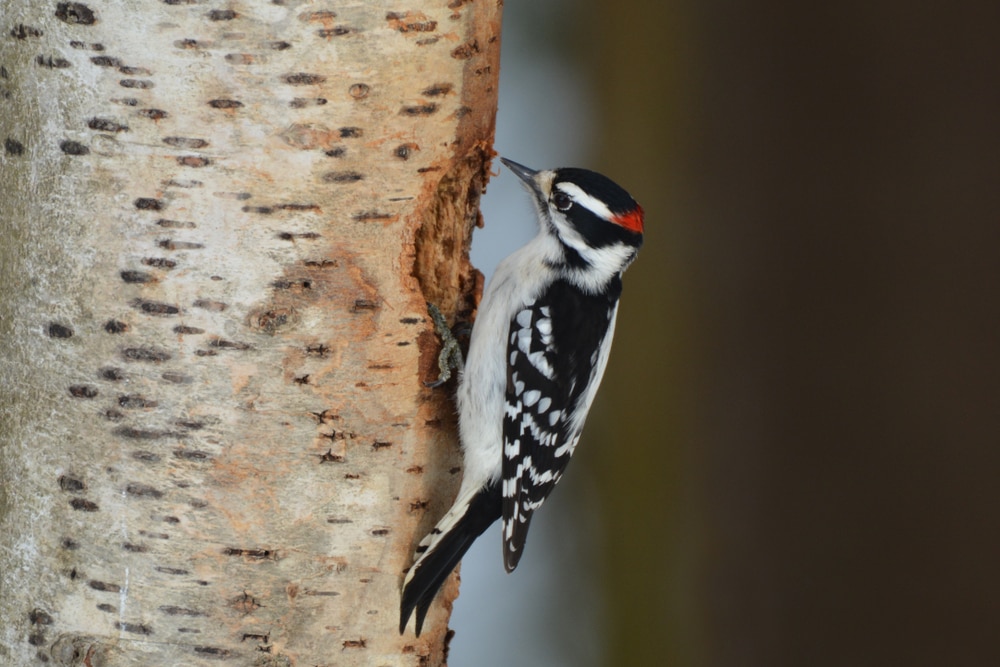
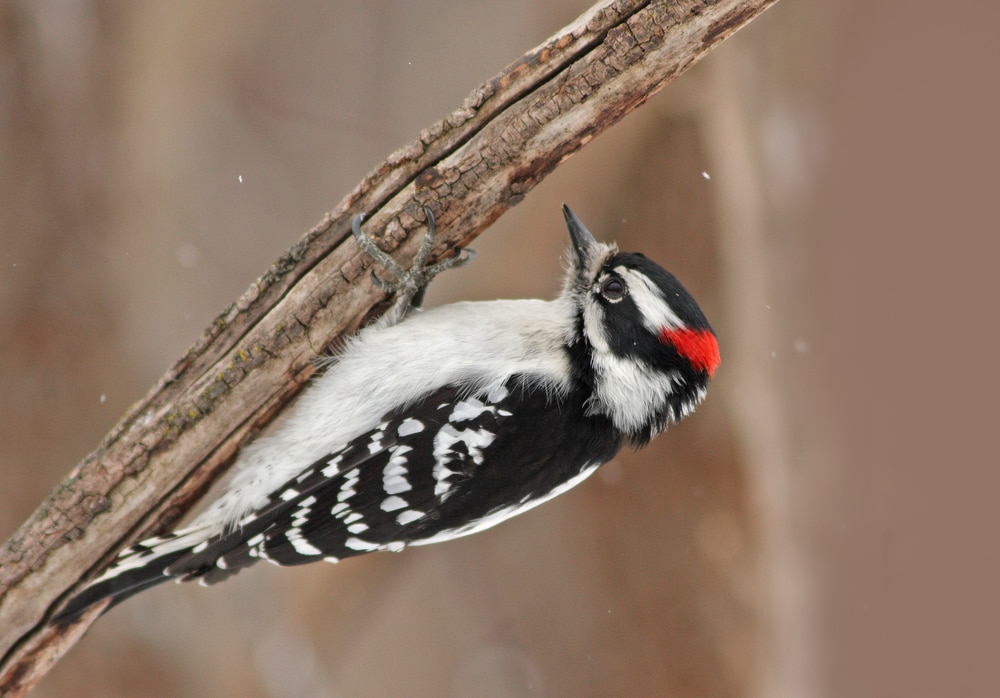
Size
A Hairy Woodpecker is 7.1 to 10.1 inches (18 cm to 25.7 cm) tall and has a 13 to 16 inch (33 cm to 40.6 cm) wingspan. Southern Hairy tend to weigh less, but the species typically 1.4 to 3.4 ounces (39.4 g to 96.4 g).
Identification
Look for the black wings checkered with white spots crawling up the trunks of a tree in your backyard. Hairy Woodpeckers will often visit feeders, giving you a good chance to see its bright red eye patch.
Note the size of its beak as well, as this is key in differentiating from the Downy. On a Hairy Woodpecker, the beak will be almost the same size as its head, assisting it in drilling for nests and insects.
Description
In Missouri, you will find them throughout the state’s forests hunting for insects. The Hairy Woodpecker loves to follow Pileated Woodpeckers. They will appear after a Pileated’s loud drumming ceases to comb the deeper tree holes in search of an easy meal.
The Hairy is widespread, you can encounter them in any backyard with just a thicket of trees. Any insect eater is a welcome backyard guest. Woodpeckers like the Hairy eat many insects we wouldn’t love having in our homes.
3. Downy Woodpecker
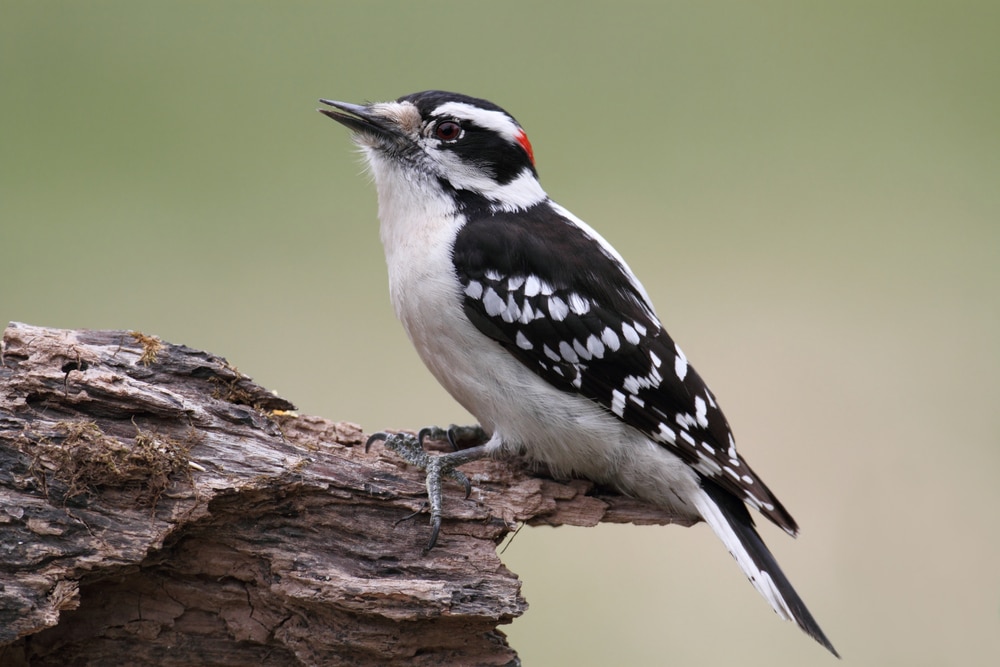
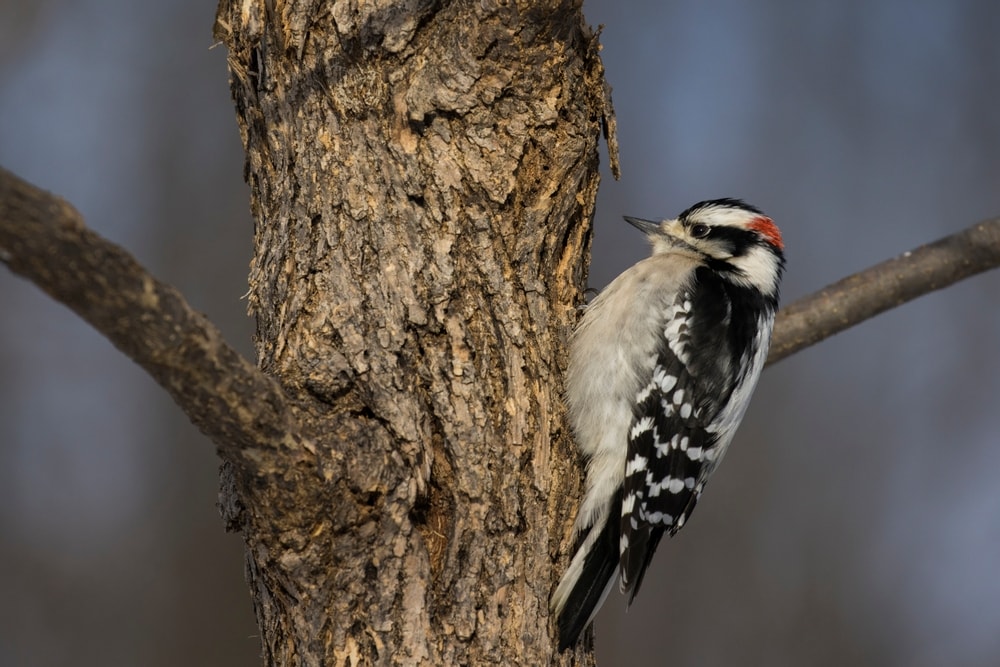
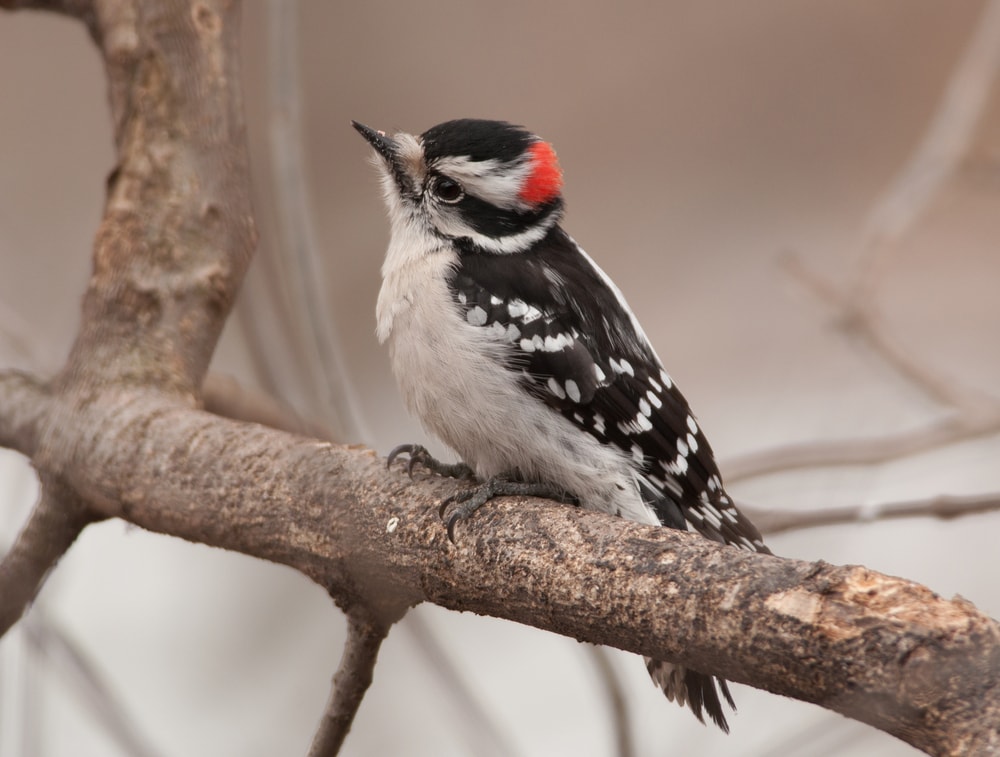
Size
North America’s smallest woodpecker stands between 5.5 and 6.7 inches (14 and 17 cm) and has a 10 to 12 inch (25.4 to 30.5 cm) wingspan. A Downy only weighs between .7 and 1 ounce (19.8 and 28.3 grams).
Identification
It does not only look like its relative, the Hairy, it also behaves similarly. If you’re confused as to whether it’s a Downy or Hairy you’re looking at, pay attention to the size. If the woodpecker is noticeably smaller than a Robin, you’ve got a Downy.
Paying attention to its size is crucial when identifying the female Downy. They are a totally black and white birds, lacking the red nape of the males.
Description
Much like its doppelganger, the Hairy, the Downy Woodpecker has a huge range across all of the United States. Missouri Downys can be seen in most wooded areas from the country to the suburbs.
A Downy will not shy away from visiting a birdfeeder, and often makes its home in suburban backyards. Their sharp ‘pik’ call is easy to distinguish from the other backyard visitors.
These woodpeckers weigh so little they can feed on the weed stalks and reeds near a forest’s edge. Downys have a noticeably smaller beak relative to the size of their head. This assists them in combing the more delicate forest plants.
4. Pileated Woodpecker
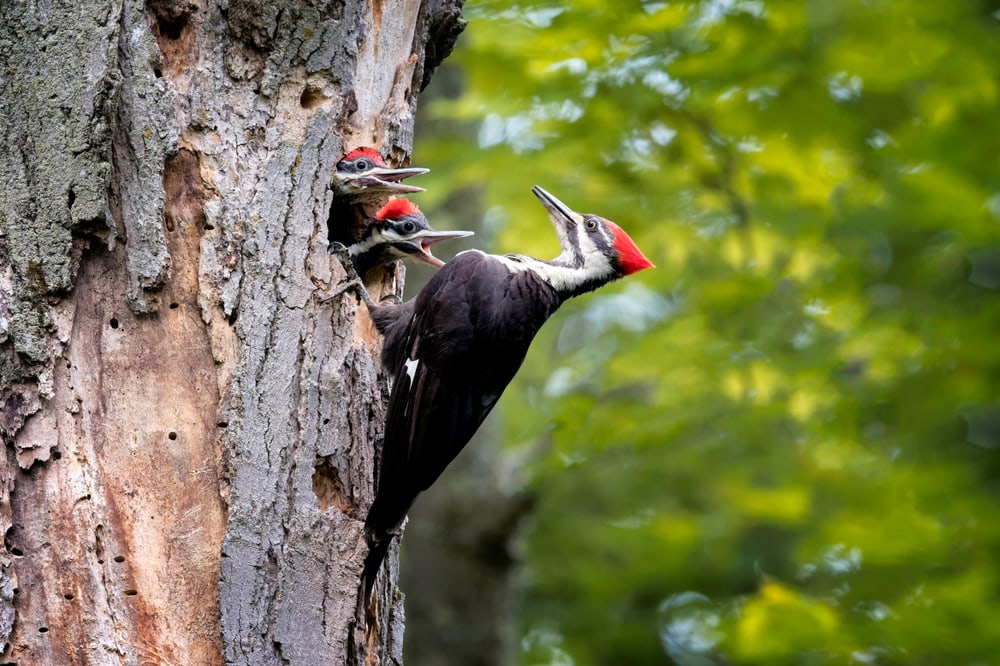
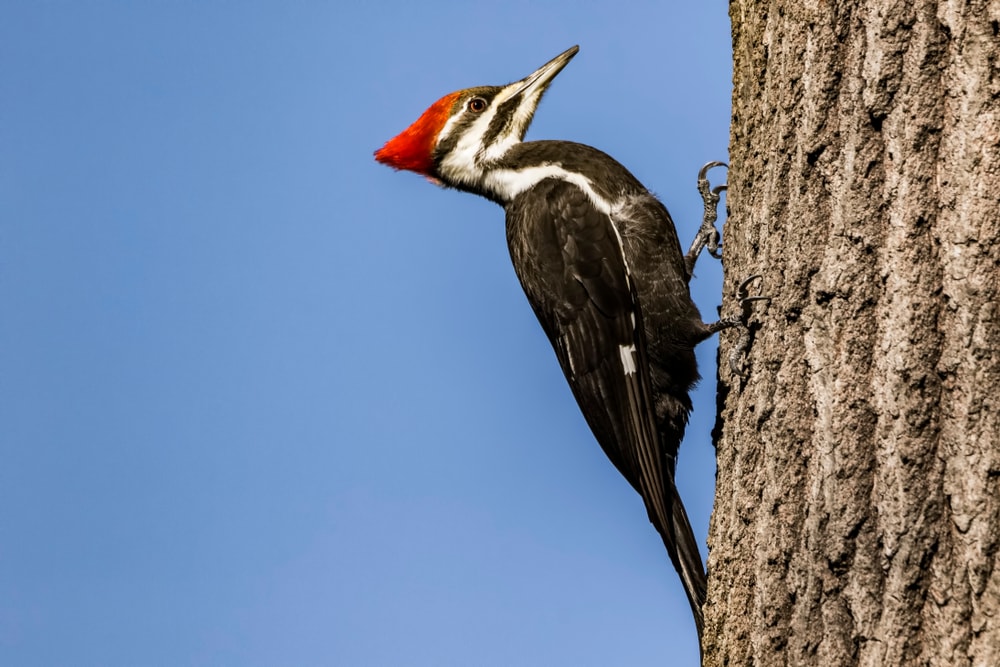
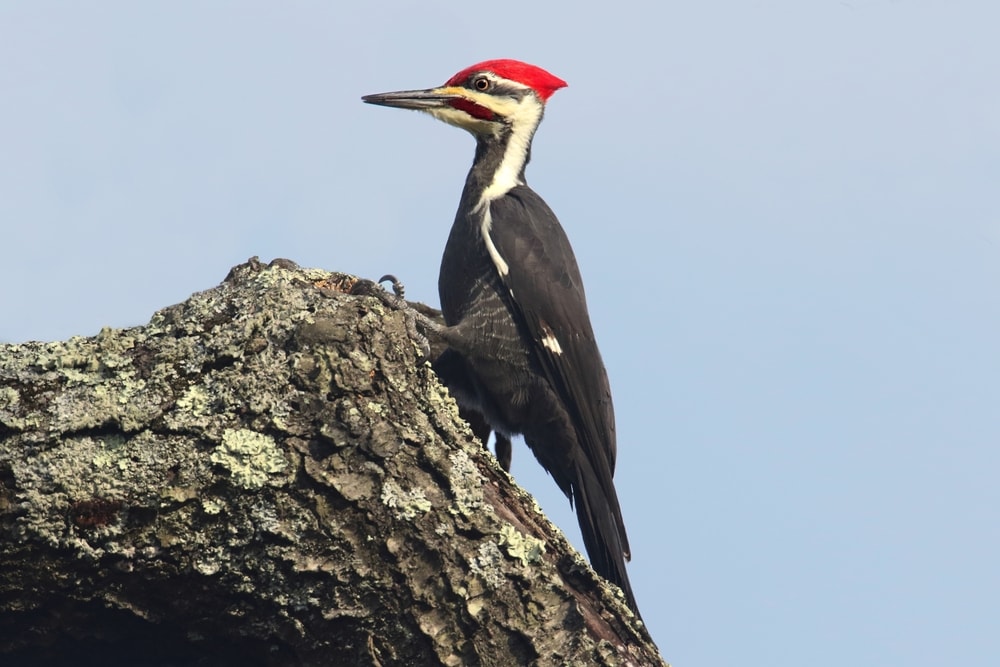
Size
Missouri’s biggest woodpecker stands 15.8 to 19.3 inches (40.1 to 49 centimeters) and has a wingspan of 26 to 29.5 inches (66 to 79.3 cm). These woodpeckers weigh 8.8 to 12.3 ounces (249.5 to 348.7 grams).
Identification
Pileated woodpeckers are one of the most striking birds of the forest. Around the size of a crow, there aren’t many bigger birds found throughout their range.
Their crimson red crest on top of their head ensures the Pileated stands out. Their large beak rests atop a very long neck, another unique ID for this bird. If you see them in flight look for the bright white patches under their wings as they bomb from tree to tree.
Without a doubt, the Pileated is the loudest drummer in the forest. If one is feeding nearby, scan the tops of large trees to try and catch one moving up the trunk. The drumming is likely going to be followed by one of their high, clear calls.
Description
The Pileated Woodpecker’s range covers most of Missouri year-round. They are commonly seen in all but the northwestern corner of the state.
These birds are real professionals of the forest, and their skill speaks for itself. When Pileated Woodpeckers feed, their drumming attracts all sorts of visitors. With the ability to drill so extensively on a tree other birds can take advantage of passed-over cavities for a free meal.
A Pileated Woodpecker also has the unique talent of being able to drill a nest almost 2 feet into a tree. After breeding season ends and they vacate, their nest offers refuge for owls, swifts, and other woodpeckers they could not have provided themselves.
5. Yellow-Bellied Sapsucker
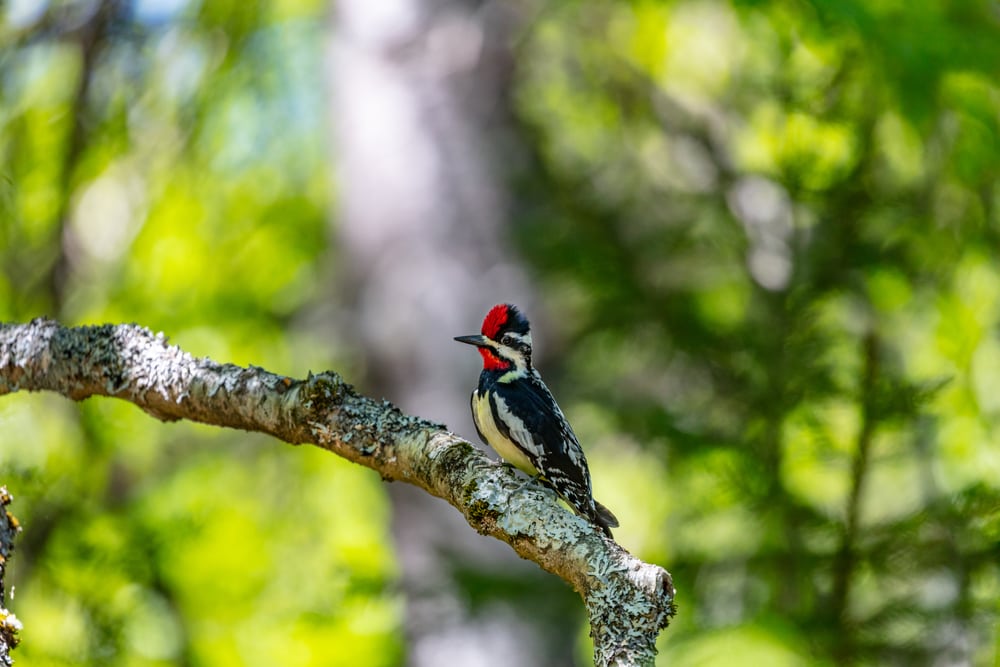
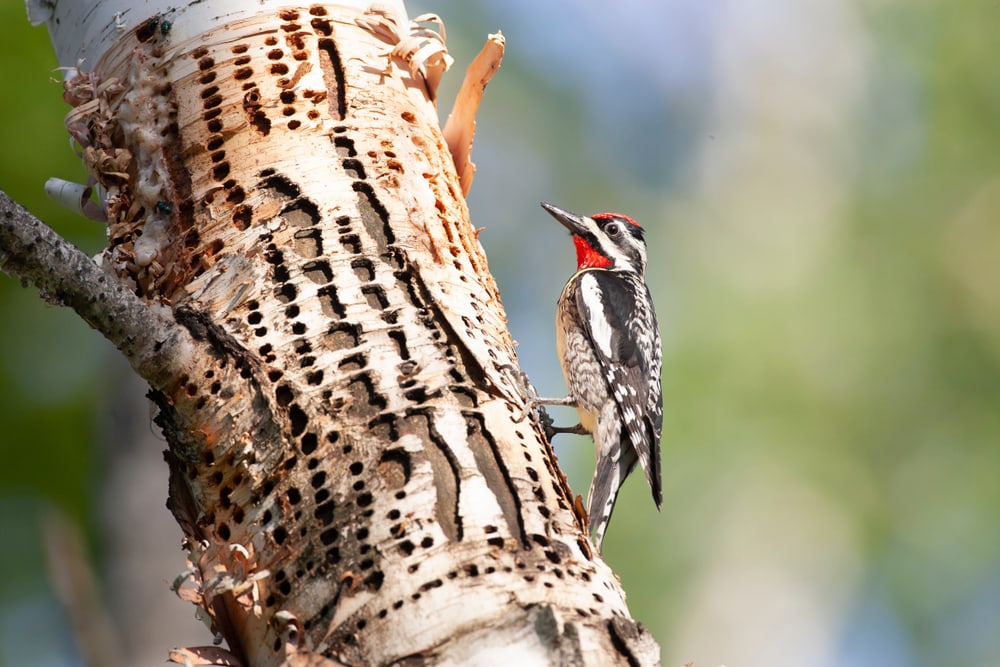
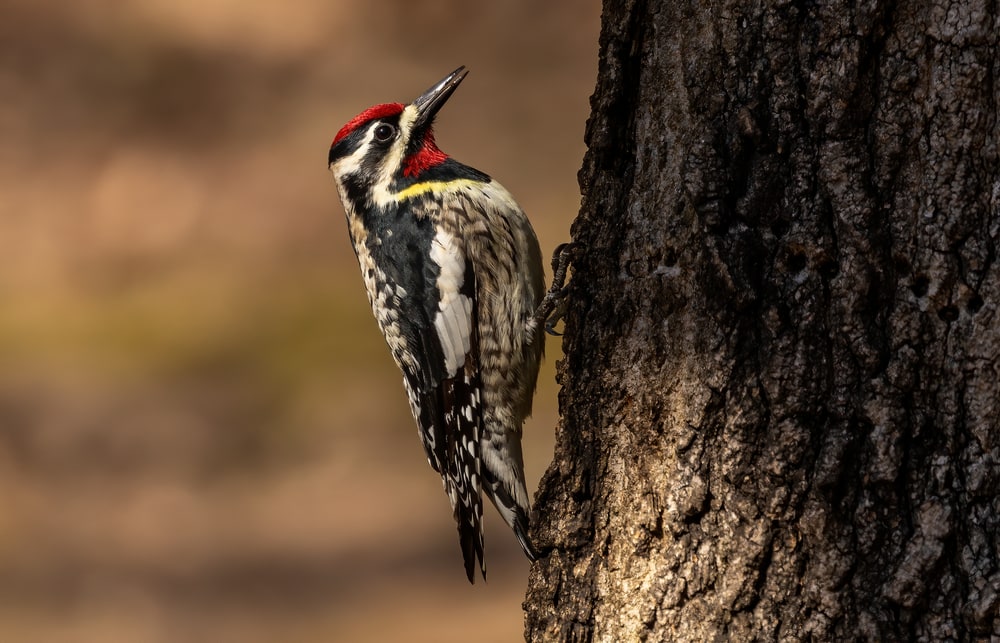
Size
Yellow-bellied Sapsuckers are slightly smaller than a Hairy Woodpecker and weigh 1.5 to 1.9 ounces (42.5 to 53.9 grams). These birds stand 7.1 to 8.7 inches (18 to 22.1 centimeters) and have a wingspan between 13.4 and 15.8 inches (34 and 40.1 cm).
Identification
These woodpeckers, especially the female, may appear similar to a Hairy working its way up the tree. From behind you’d only be able to see the similar checkerboard pattern of the wings and back.
The name implies where to look for the difference, all yellow-bellied sapsuckers will have a yellow hue to their white belly. Males of the species also have a bright red throat to match their cap.
All species of sapsuckers drum slower and more irregularly than woodpeckers. Since it is the only sapsucker in Missouri, their drumming is one of the easiest ways to ID the bird. Their call is distinct too. Loud ‘quee-ah’ calls can be heard from the trees during the breeding season.
Description
The Yellow-bellied Sapsucker’s breeding range splits Missouri pretty well down the I-70 line. This allows them to be seen year-round in the state at different times of the year. During the breeding season, they tend to stay in the north of the state before moving south for winter.
Their diet differs from all others on the list, opting to drill for sap rather than insects. Their narrow diet has sharpened their drilling skills. The Yellow-bellied can drill small holes to probe for sap or rectangular ones where sap flows.
Access to sugary sap is coveted by many species. Hummingbirds will anticipate the arrival of sapsuckers to time their migration route. If the Sapsuckers have arrived, hummingbirds are assured they will have the sap to fuel their journey.
6. Red-Bellied Woodpecker
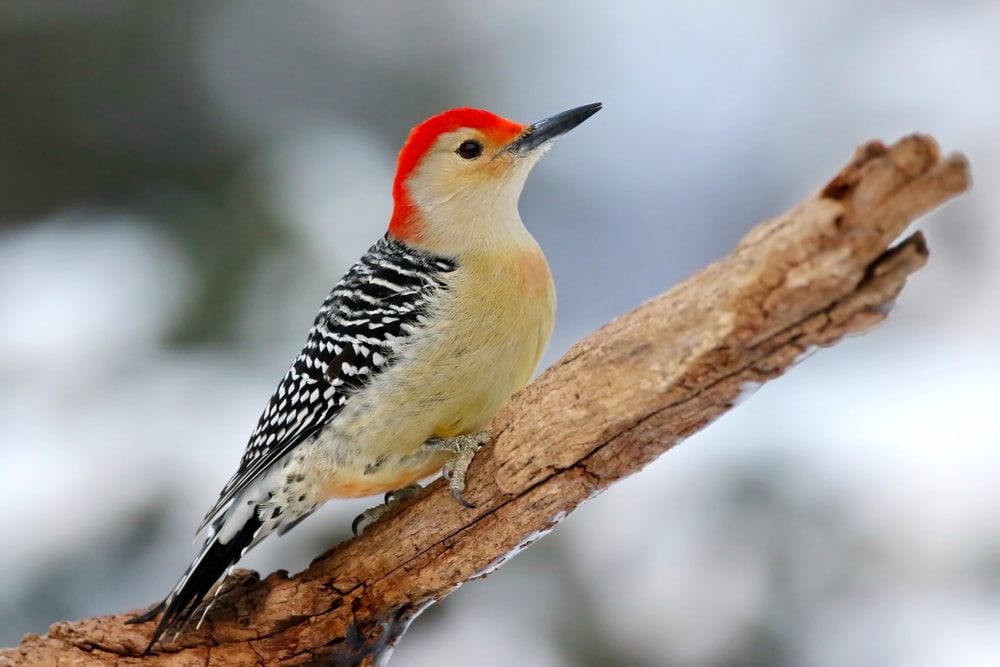
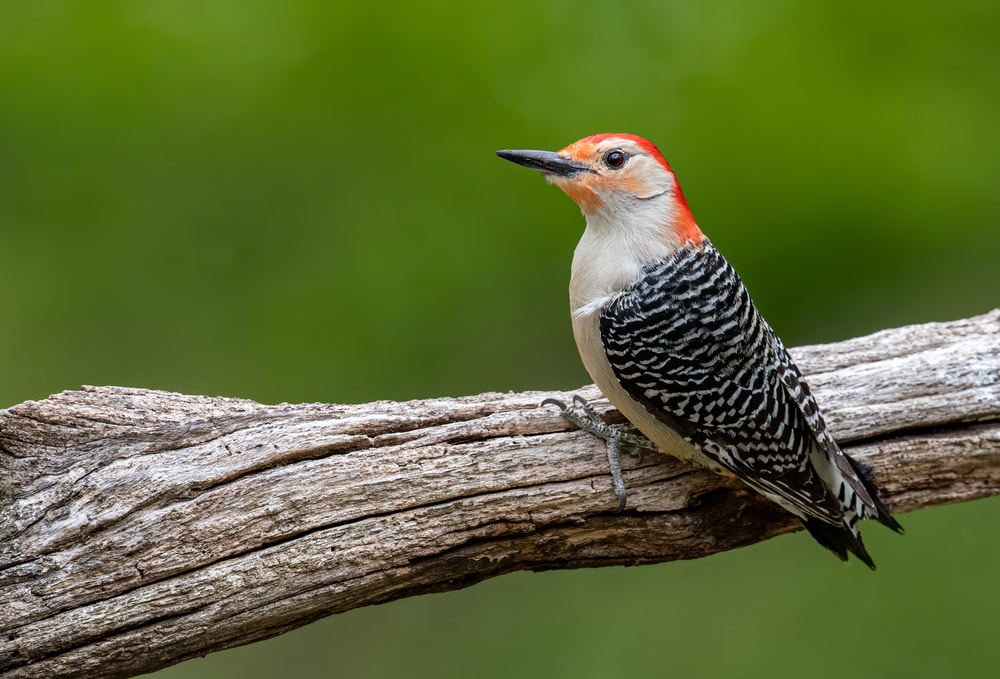
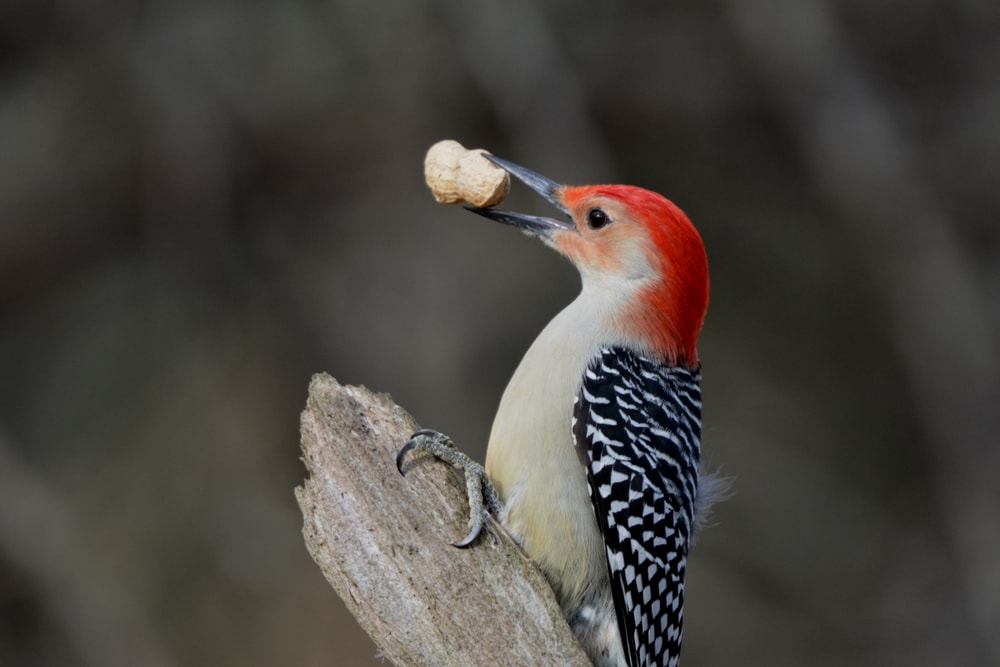
Size
Red-Bellied Woodpeckers are slightly larger than a Robin at 9.4 inches (23.9 centimeters) tall. Their wingspan is 13 to 16.5 inches (33 to 41.2 cm), and they weigh 2 to 3.2 ounces (56.7 to 90.7 grams).
Identification
This medium-sized black and white barred woodpecker looks like its relative the Flicker. To distinguish the two on appearance, check the red cap on the head or nape of the neck.
If you are a novice birdwatcher the red cap may fool you into thinking you’ve seen a Red-headed Woodpecker. The red on a Red-bellied Woodpecker’s head only extends to their cap and nape, whereas red-headed woodpeckers have an entirely red head.
The Red-bellied name is a bit of a misnomer. Their entire underside is a shade of pale grey on males and females most of the year. Only during the breeding season will you see tufts of red appear on the male’s chest.
Description
Their range extends over all of Missouri, and they live in the state year-round. These forest dwellers are not shy about coming to a feeder, especially a suet block. If they seize on a suet feeder, they have the potential to dominate.
Their dominance does not extend to their nests. In Missouri, where they overlap with European Starlings, their nests are often taken over with little fanfare. This can have some woodpeckers drilling out many nests before they find a permanent home.
The Red-bellied Woodpecker’s tongue is perhaps its most unique evolution. It can extend out two inches from the beak and comes equipped with barbs. This makes them efficient feeders, able to access parts of the tree typically only available to the Pileated.
7. Red-Headed Woodpecker
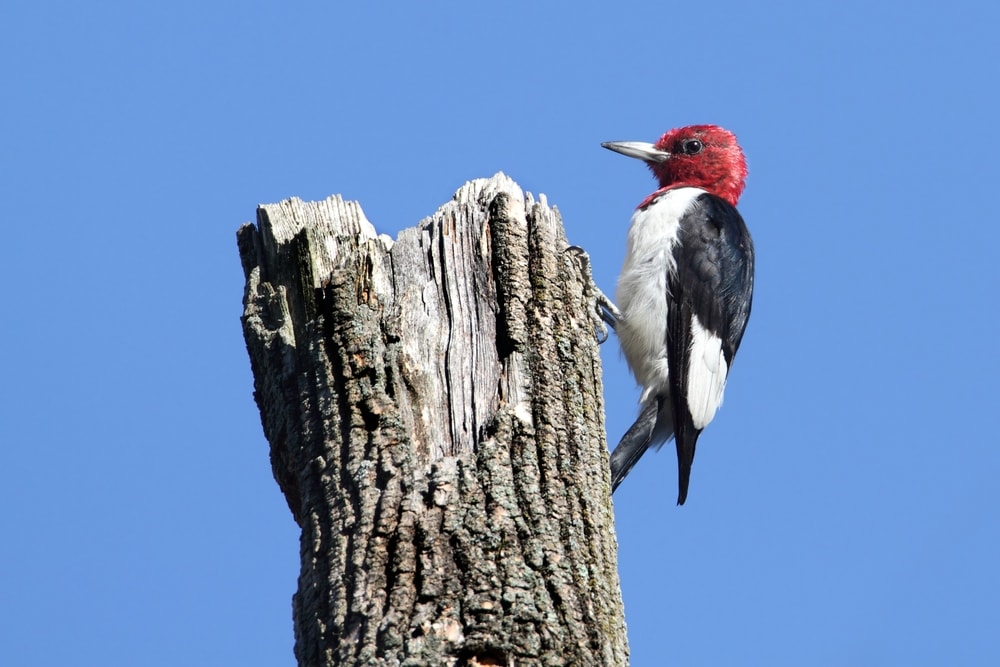
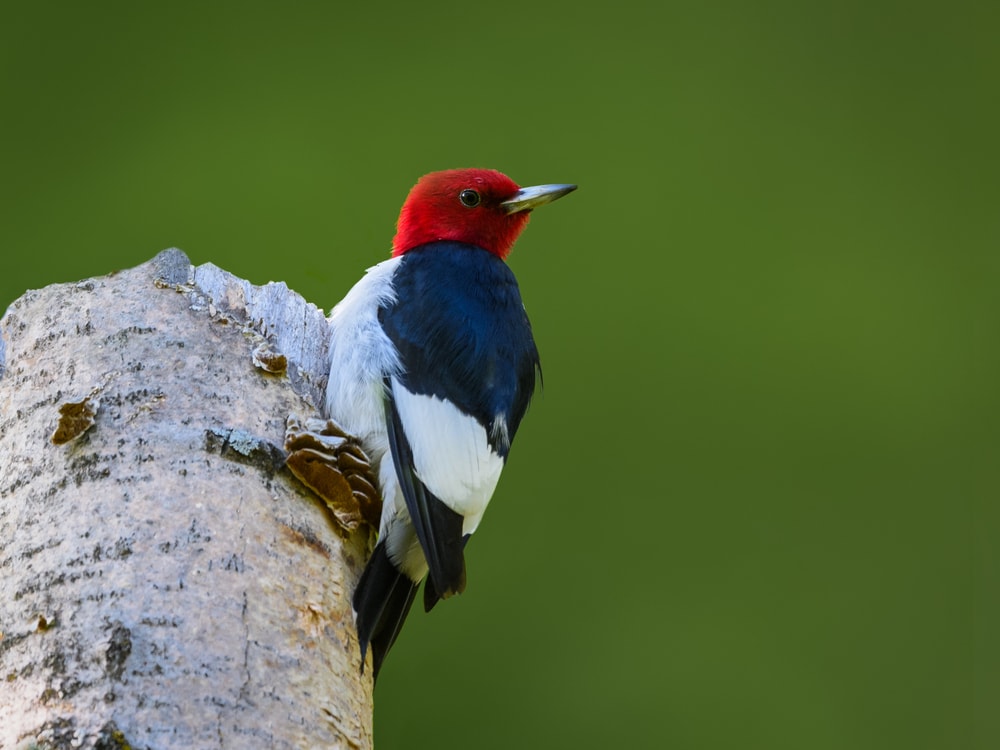
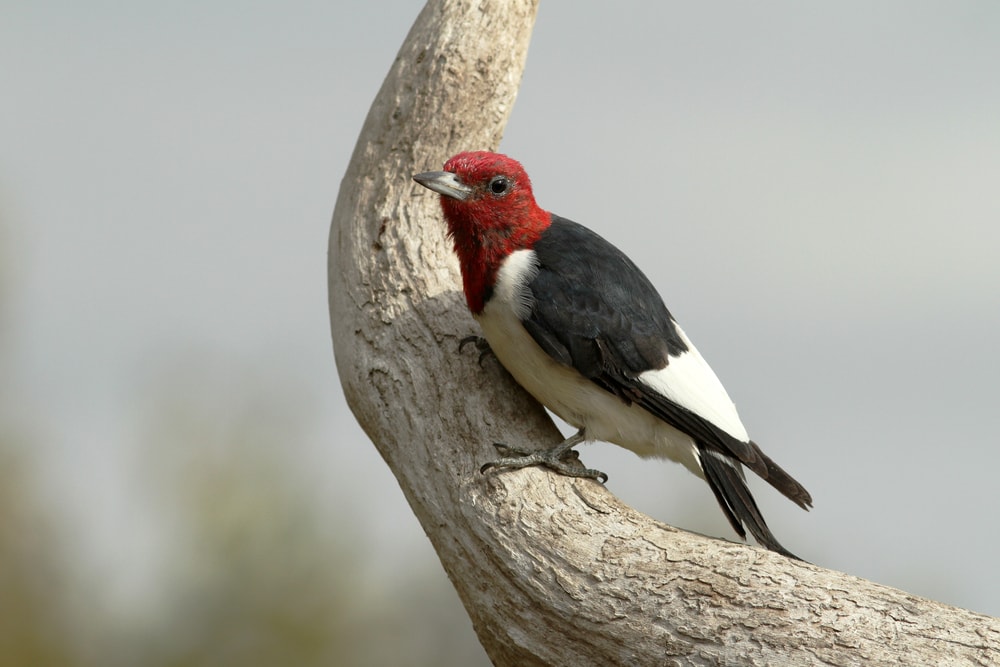
Size
A Red-Headed Woodpecker’s length is 7.5 to 9.1 inches (19.1 to 23.1 centimeters) with a wingspan 16.5 inch (41.2 cm) wingspan. They typically weigh 2 to 3.2 ounces (56.7 to 90.7 grams).
Identification
Missouri’s most brilliant woodpecker is identified by its obvious bright red head. They are the only species on the list where male and female species appear almost identical. Their backs are deep black with white wing tips to match the underside of the bird.
The short ‘churr’ call is the most commonly identified. It’s similar to a red-bellied call but is a degree more piercing. It can almost sound like the first burst of a fire alarm.
Description
The Red-headed Woodpecker is native to Missouri all year, inhabiting forests around the state. They comb and fly amongst trees in pursuit of insects before switching to nuts and fruit in the winter.
There are a few behaviors unique to the Red-headed species. It is among the most skilled flycatchers in the woodpecker family, opting to feed in the air more than on a tree. This behavior makes identification easier, especially in Missouri. They are the only woodpecker in the state that will chase insects in flight
As the weather cools, the Red-headed Woodpecker begins to store caches of food for the slower winter months. It is the only woodpecker species observed actively hiding its food. They will drill small storage cavities and then cover them over with pieces of bark.








